The Food Recycler Market is estimated to be valued at USD 46.6 billion in 2025 and is projected to reach USD 80.4 billion by 2035, registering a compound annual growth rate (CAGR) of 5.6% over the forecast period.
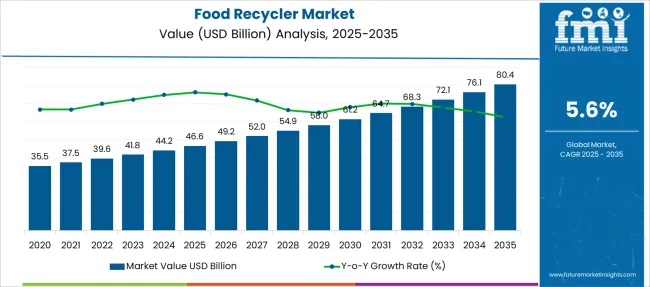
| Metric | Value |
|---|---|
| Food Recycler Market Estimated Value in (2025 E) | USD 46.6 billion |
| Food Recycler Market Forecast Value in (2035 F) | USD 80.4 billion |
| Forecast CAGR (2025 to 2035) | 5.6% |
The food recycler market is witnessing strong momentum globally due to the rising need for sustainable waste management practices and circular economy solutions. Governments and municipalities are increasingly encouraging decentralized organic waste processing through household and commercial composting devices, stimulating demand for automated food recycling solutions. Innovations in compact designs, odor control systems, and energy-efficient processing technologies have enhanced product appeal, particularly in urban settings.
Additionally, heightened awareness about landfill pollution, climate change, and methane emissions has led to increased adoption among environmentally conscious consumers and institutions. The integration of smart features such as IoT monitoring, app connectivity, and programmable composting cycles has positioned food recyclers as part of modern smart-home ecosystems.
As green regulations tighten and the zero-waste movement gains pace, manufacturers are expected to benefit from favorable policies, tax rebates, and subsidies This broader support ecosystem is projected to catalyze further adoption, especially in North America, Europe, and parts of Asia Pacific over the coming years.
The market is segmented by Component, Price range, Sales Channels, Material type, and End Use and region. By Component, the market is divided into Product and Services. In terms of Price range, the market is classified into Economic and Premium. Based on Sales Channels, the market is segmented into Online and Offline. By Material type, the market is divided into Steel, Stainless steel, Carbon Steel, Plastic, Fiber, and Others. By End Use, the market is segmented into Residential and Commercial. Regionally, the market is classified into North America, Latin America, Western Europe, Eastern Europe, Balkan & Baltic Countries, Russia & Belarus, Central Asia, East Asia, South Asia & Pacific, and the Middle East & Africa.
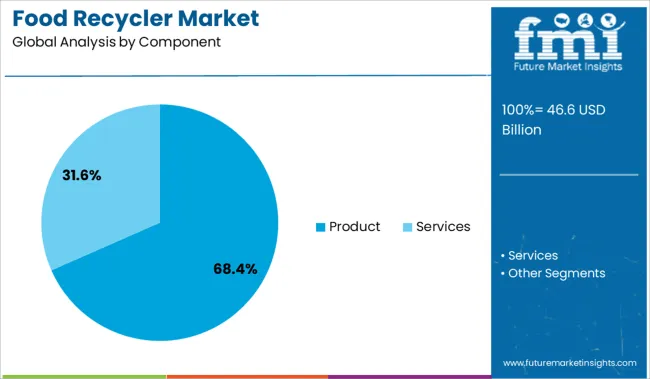
The product segment is expected to account for 68.4% of the total revenue share in the food recycler market in 2025, highlighting its central role in delivering consumer value. This dominance has been driven by consistent innovation in hardware design, greater operational efficiency, and improved user convenience. Manufacturers have focused on enhancing durability, speed of decomposition, and ease of installation to appeal to a wider demographic, including households, small businesses, and institutions.
Demand for standalone, plug-and-play units has remained strong due to their portability, quiet operation, and fast cycle times. Furthermore, increased investments in product engineering have supported the integration of multi-stage grinding, thermal drying, and air filtration, enhancing the overall performance and reliability of devices.
As more consumers shift from traditional composting methods to automated solutions, the product segment is expected to continue driving volume and value growth Long-term value perception and declining price points are also encouraging wider household penetration globally.
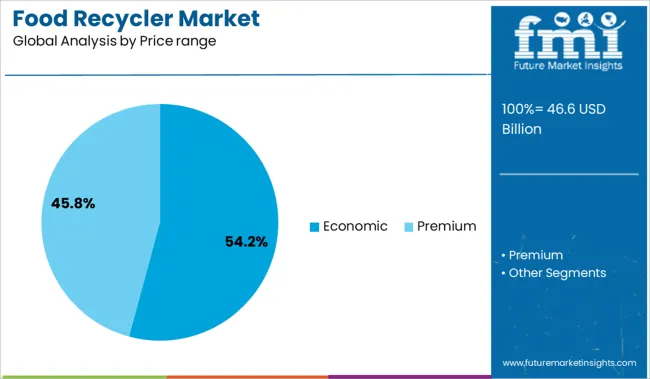
The economic price range segment is projected to hold 54.2% of the overall revenue share in the food recycler market in 2025. The affordability of entry-level and mid-tier models has played a pivotal role in increasing product accessibility, particularly among price-sensitive households and first-time adopters. Growing environmental consciousness, paired with budget constraints in emerging economies, has led consumers to opt for cost-effective food recyclers that offer essential functionality without advanced features.
Manufacturers have responded by scaling down non-essential components and focusing on core performance metrics such as composting speed, energy usage, and safety. This approach has helped maintain quality while keeping costs competitive. Additionally, economic models are often more compact and easier to operate, making them ideal for urban dwellers with limited space.
The segment's growth is also being reinforced by bulk procurement initiatives by local municipalities and schools, which prefer lower-cost units for public use As awareness spreads and volumes increase, economies of scale are expected to further drive adoption within this price band.
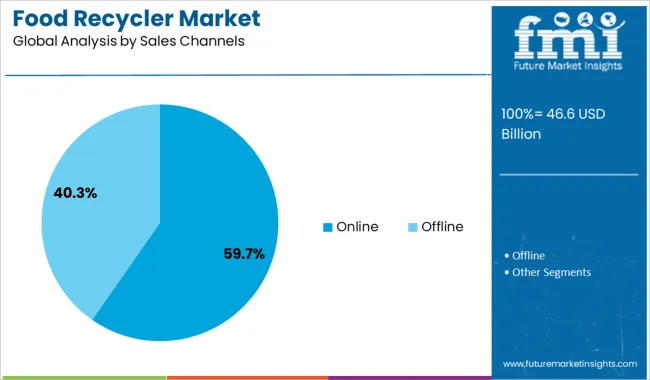
The online sales channel is expected to contribute 59.7% of the total revenue share in the food recycler market in 2025, making it the dominant distribution route. The growing preference for digital retail platforms has been accelerated by convenience, wider product availability, and competitive pricing. Consumers are increasingly relying on e-commerce to compare features, read peer reviews, and access exclusive discounts, especially for sustainable home appliances.
Online platforms have enabled manufacturers and third-party sellers to reach customers across tier 2 and tier 3 cities without significant investment in physical retail infrastructure. Enhanced delivery logistics, easy return policies, and financing options have further strengthened consumer confidence in purchasing high-ticket appliances online.
Additionally, the presence of educational content and sustainability certifications on product pages has positively influenced environmentally driven buying behavior As the digitalization of consumer appliances continues, the online channel is expected to play an even more integral role in shaping brand loyalty and driving market penetration across geographies.
Major Drivers for Global Food Recycler Market
Increasing urbanization, smart city projects in developing countries and government initiatives such as the go green concept is expected to positively influence the demand for food recycler components across the globe.
Increasing people's awareness of the food recycling process and devices and increasing concern for the environment is expected to increase the sales of food recycler components in the near future.
Opportunities for the Global Food Recycler Market
Technological advancements pertaining to food recycling and composition techniques in countries such as China, Japan and others are expected to register new growth opportunities for sales of food recycler components during the forecast period.
Moreover, the introduction of food recyclers with affordable prices by manufacturers in the near future is expected to fuel the demand for food recycler market share during the forecast period.
Major Challenges for Food Recycler Market
The high price of food recyclers is one of the main reasons limiting the sales of food recycler components. Generally, the middle-income population is showing a lack of interest in purchasing food recycles due to its high costs.
Higher investment in developing cold chain facilities in different parts of the world has some potential to decrease the pace of growth in food recycler market share in some economies.
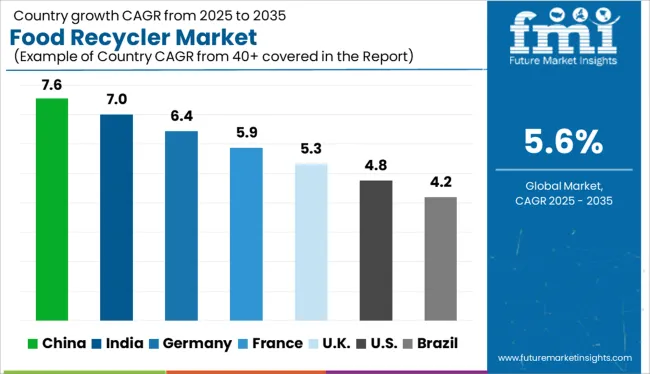
North America and Europe are expected to hold a significant amount of food recycler market share in the global market due to technological advancements pertaining to food recycling and composting techniques.
An increasing number of manufacturers of food recyclers in the Asia Pacific region is expected to fuel the sales of food recycler in the near future in the region, in terms of volume. The demand for food recycler components in Latin America market is expected to witness moderate growth in the near future due to increasing disposable income in the region.
Moreover, the lack of technological advancement (pertaining to food recycling devices) in developing countries such as India, Mexico, and others restrict sales of food recycler in the country itself. Thus higher import and logistics cost decreases the food recycler market share in such countries.
The Middle East and Africa are witnessing a slow growth of the food recycler market. However, increasing public concern for the environment and increasing urbanization in the region are expected to positively grow the demand for food recycler components in the Latin America market during the forecast period.

Some of the key players in the global food recycler market includes Whirlpool's, Food Cycle Science, Wastefox, Joseph Joseph, Nine Stars Group (USA) Inc., Simplehuman, Smart Cara, Food Cycler, and Mares Group.
Major Developments in the Food Recycler Market
| Report Attribute | Details |
|---|---|
| Growth Rate | CAGR of 5.6% from 2025 to 2035 |
| Base Year of Estimation | 2024 |
| Historical Data | 2014 to 2024 |
| Forecast Period | 2025 to 2035 |
| Quantitative Units | Revenue in USD Billion, Volume in Kilotons and CAGR from 2025-2035 |
| Report Coverage | Revenue Forecast, Volume Forecast, Company Ranking, Competitive Landscape, Growth Factors, Trends and Pricing Analysis |
| Segments Covered | Component, Price Range, Distribution Channel, Material Type, End Use, Region |
| Regions Covered | North America; Latin America; Western Europe; Eastern Europe; APEJ; Japan; Middle East and Africa |
| Key Countries Profiled | USA, Canada, Brazil, Argentina, Germany, UK, France, Spain, Italy, Nordics, BENELUX, Australia & New Zealand, China, India, ASEAN, GCC, South Africa |
| Key Companies Profiled | Whirlpool's; Food Cycle Science; Wastefox; Joseph Joseph; Nine Stars Group (USA) Inc.; Simplehuman; Smart Cara; Food Cycler; Mares Group |
| Customization scope | Available Upon Request |
| Pricing and Purchase Option | Avail Customized purchase options to meet your exact research needs. |
The global food recycler market is estimated to be valued at USD 46.6 billion in 2025.
The market size for the food recycler market is projected to reach USD 80.4 billion by 2035.
The food recycler market is expected to grow at a 5.6% CAGR between 2025 and 2035.
The key product types in food recycler market are product and services.
In terms of price range, economic segment to command 54.2% share in the food recycler market in 2025.






Our Research Products

The "Full Research Suite" delivers actionable market intel, deep dives on markets or technologies, so clients act faster, cut risk, and unlock growth.

The Leaderboard benchmarks and ranks top vendors, classifying them as Established Leaders, Leading Challengers, or Disruptors & Challengers.

Locates where complements amplify value and substitutes erode it, forecasting net impact by horizon

We deliver granular, decision-grade intel: market sizing, 5-year forecasts, pricing, adoption, usage, revenue, and operational KPIs—plus competitor tracking, regulation, and value chains—across 60 countries broadly.

Spot the shifts before they hit your P&L. We track inflection points, adoption curves, pricing moves, and ecosystem plays to show where demand is heading, why it is changing, and what to do next across high-growth markets and disruptive tech

Real-time reads of user behavior. We track shifting priorities, perceptions of today’s and next-gen services, and provider experience, then pace how fast tech moves from trial to adoption, blending buyer, consumer, and channel inputs with social signals (#WhySwitch, #UX).

Partner with our analyst team to build a custom report designed around your business priorities. From analysing market trends to assessing competitors or crafting bespoke datasets, we tailor insights to your needs.
Supplier Intelligence
Discovery & Profiling
Capacity & Footprint
Performance & Risk
Compliance & Governance
Commercial Readiness
Who Supplies Whom
Scorecards & Shortlists
Playbooks & Docs
Category Intelligence
Definition & Scope
Demand & Use Cases
Cost Drivers
Market Structure
Supply Chain Map
Trade & Policy
Operating Norms
Deliverables
Buyer Intelligence
Account Basics
Spend & Scope
Procurement Model
Vendor Requirements
Terms & Policies
Entry Strategy
Pain Points & Triggers
Outputs
Pricing Analysis
Benchmarks
Trends
Should-Cost
Indexation
Landed Cost
Commercial Terms
Deliverables
Brand Analysis
Positioning & Value Prop
Share & Presence
Customer Evidence
Go-to-Market
Digital & Reputation
Compliance & Trust
KPIs & Gaps
Outputs
Full Research Suite comprises of:
Market outlook & trends analysis
Interviews & case studies
Strategic recommendations
Vendor profiles & capabilities analysis
5-year forecasts
8 regions and 60+ country-level data splits
Market segment data splits
12 months of continuous data updates
DELIVERED AS:
PDF EXCEL ONLINE
Food & Beverage OEE Software Market Size and Share Forecast Outlook 2025 to 2035
Food Grade Crosslinked Polyvinylpolypyrrolidone (PVPP) Market Size and Share Forecast Outlook 2025 to 2035
Food Grade Cassia Gum Powder Market Size and Share Forecast Outlook 2025 to 2035
Food Grade Dry Film Lubricant Market Size and Share Forecast Outlook 2025 to 2035
Foodservice Equipment Market Analysis - Size, Share, and Forecast Outlook 2025 to 2035
Food Basket Market Forecast and Outlook 2025 to 2035
Food Grade Tremella Polysaccharide Market Size and Share Forecast Outlook 2025 to 2035
Food Sorting Machine Market Size and Share Forecast Outlook 2025 to 2035
Foodservice Paper Bag Market Size and Share Forecast Outlook 2025 to 2035
Food Stabilizers Market Size and Share Forecast Outlook 2025 to 2035
Food Packaging Film Market Size and Share Forecast Outlook 2025 to 2035
Food Certification Market Size and Share Forecast Outlook 2025 to 2035
Food Tray Market Size and Share Forecast Outlook 2025 to 2035
Food & Beverage Industrial Disinfection and Cleaning Market Size and Share Forecast Outlook 2025 to 2035
Food Technology Market Size and Share Forecast Outlook 2025 to 2035
Food Tourism Sector Market Size and Share Forecast Outlook 2025 to 2035
Food Processing Boiler Market Size and Share Forecast Outlook 2025 to 2035
Food Packaging Machines Market Size and Share Forecast Outlook 2025 to 2035
Food Minerals Market Size and Share Forecast Outlook 2025 to 2035
Food And Beverage Chemicals Market Size and Share Forecast Outlook 2025 to 2035

Thank you!
You will receive an email from our Business Development Manager. Please be sure to check your SPAM/JUNK folder too.
Chat With
MaRIA